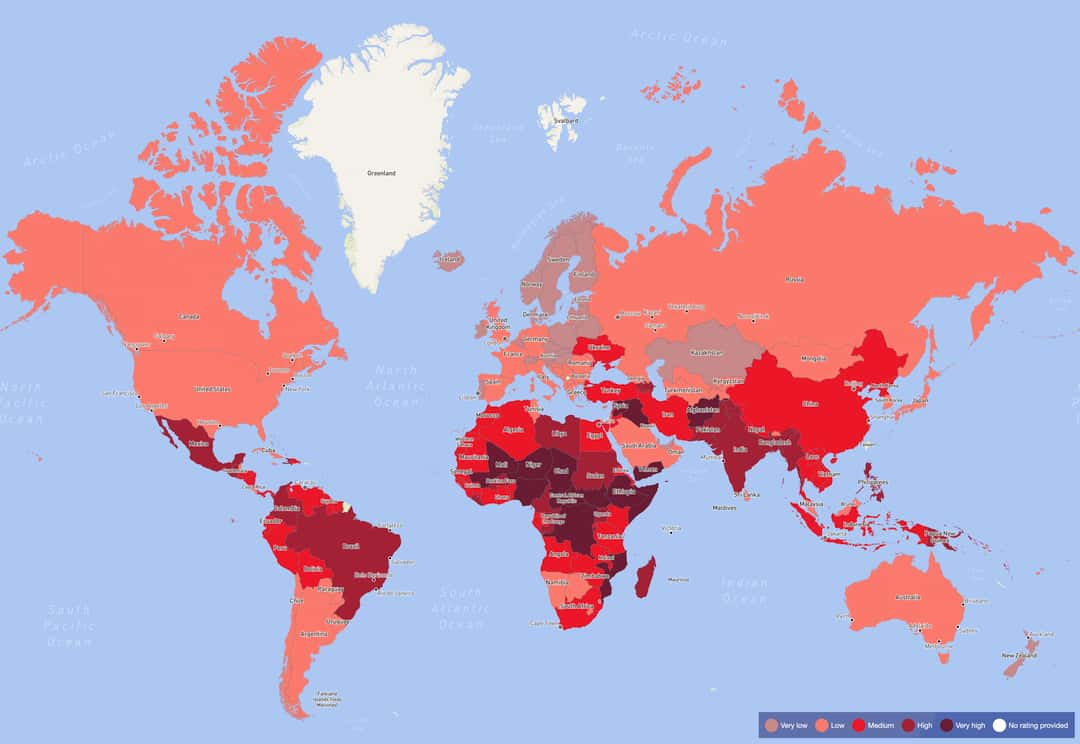We all crave safe travels and unforgettable experiences. However, finding the perfect destination has become increasingly challenging in a world shaped by geopolitical tensions, natural disasters, and health uncertainties. International SOS’s annual Risk Map 2025 analyzes the global security landscape, empowering travelers to make informed decisions.
This map assesses countries and regions based on crucial factors such as healthcare infrastructure, crime rates, environmental risks, political stability, and transportation networks. The goal is to alert tourists and businesses to potential hazards, ensuring that travel plans are made with both safety and awareness in mind.
The assessment is based on a color scale:
- Green: Insignificant risk
- Yellow: Low risk
- Orange: Medium risk
- Light Red: High risk
- Dark Red: Extreme risk
These colors provide an easy way to quickly identify which regions are considered safe or risky. However, while the color coding offers a quick overview, it is important to also consider the deeper factors that influence a country's overall safety.

Security map, source: Risk Map/International SOS/Screenshot
The Changing World: Where Risks Are Particularly High
In many parts of the world, the situation has worsened. This is particularly evident in the Middle East, where regions like Gaza, the West Bank, Iran, and Lebanon are classified as “extreme risk.” Other countries such as Sudan, Myanmar, Somalia, Yemen, Syria, Niger, the Central African Republic, and Burkina Faso also rank among the most dangerous globally. These nations face war, terrorism, political instability, and, in some cases, humanitarian crises. For tourists and photographers planning to travel to these regions, thorough preparation and constant monitoring of the security situation are essential.
Europe: Less Safe Than Expected?
Europe, long regarded as one of the safest travel regions, is also showing signs of increasing risk. Countries like France, Spain, Sweden, and the United Kingdom are now categorized as “moderate risk.” This shift is due to factors such as political unrest, social protests, and environmental disasters like storms and floods that affected many cities last year. Nations like Italy, the Netherlands, and Poland are also seeing rising risks due to political tensions and natural events.
A Silver Lining: Safe and Beautiful Travel Destinations
Despite these challenges, Europe still offers numerous destinations that are considered particularly safe. Countries like Germany, Switzerland, Luxembourg, Belgium, Finland, Iceland, and Norway remain among the safest places to visit. These countries not only offer political stability but also breathtaking landscapes and cultural treasures. Beyond Europe, many other countries are also known for their high safety levels. Canada, Australia, New Zealand, Singapore, and Japan boast excellent quality of life, stable political conditions, and low crime rates. In Africa, Botswana and the Seychelles stand out as safer destinations, offering photographers the chance to capture breathtaking wildlife and pristine nature. South America also has safe options, with Uruguay and Chile being notable examples.
For those seeking urban experiences, there are also plenty of cities to explore. Bern, Switzerland, is ranked as the safest city in the world, followed by Doha, Melbourne, Montreal, Muscat, Ottawa, and Seoul. These cities offer a wealth of photographic opportunities, from historic landmarks to modern skylines.
Climate Change: Traveling in the Age of Extreme Weather Events
As climate change progresses, careful planning has become more critical than ever. Extreme weather conditions are becoming more common in many travel regions. North Africa and the Middle East are particularly affected, where heatwaves, drought, and water shortages exacerbate the climatic challenges. Countries like Egypt, Jordan, Syria, and Iraq face extremely high temperatures (over 40°C) during the summer months (May to September). Gulf states like Saudi Arabia, the UAE, and Oman experience similarly hot summer months, making winter travel (November to February) a better option. The Horn of Africa (e.g., Somalia, Ethiopia, Eritrea) and the Sahel region (e.g., Sudan, Mali, Chad) are particularly vulnerable to drought, heatwaves, and political crises. The months between May and October can be critical due to extreme weather, so travel during these months can be risky. November to February, when the weather is milder, is safer. In Southeast Asia, countries like Vietnam, Thailand, and the Philippines are increasingly affected by storms and floods, with the summer months being especially risky. Travel during the dry season (December to February) is recommended. In South America, countries in the Amazon region (e.g., Brazil, Colombia) face frequent flooding and extreme rainfall, especially from December to March, when severe storms are common.

Climate change map, source: Risk Map/International SOS/Screenshot
Medical Risk: Countries with the best and worst healthcare
The International SOS 2025 Risk Map includes a comprehensive overview of medical risks worldwide, offering insights into healthcare accessibility, quality, and infrastructure across various countries. This map evaluates factors such as the availability of emergency services, the prevalence of infectious diseases, and the robustness of local medical systems, helping travelers assess how safe it is to visit a destination based on healthcare-related risks. Countries are categorized from low to extreme risk, providing essential guidance for individuals and organizations planning travel or operations in diverse regions. It serves as a critical tool for ensuring preparedness and prioritizing safety in health-related travel concerns.

Medical map, source: Risk Map/International SOS/Screenshot
Discovering the World Without Fear
It’s important to remember that travel is always a personal experience. While the Risk Map provides valuable insights, the safety of a trip often depends on personal caution and local conditions. Within each country, some areas are safer, and others are more risky. For photographers, who often venture off the beaten path, it’s crucial to remain aware that safety can be influenced by local situations and unforeseen events. Ultimately, travel will always be an adventure, with its ups and downs. However, with proper preparation, reliable information, and a vigilant mindset, even in uncertain times, unforgettable experiences can still be had.





Comments (8)